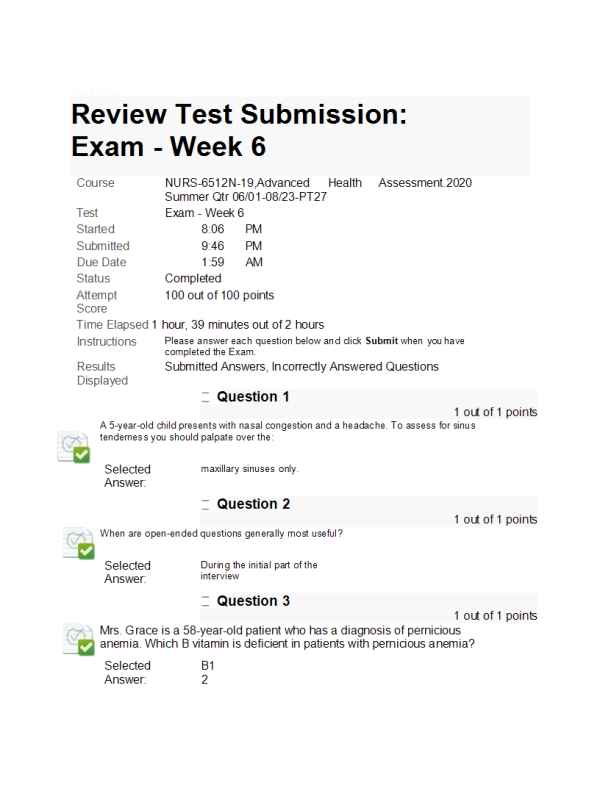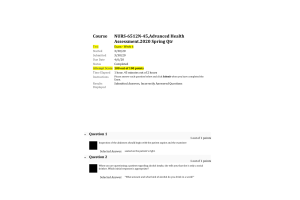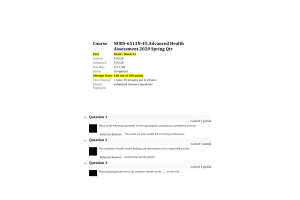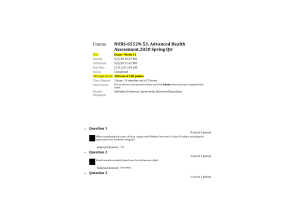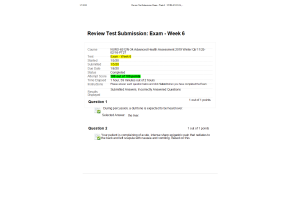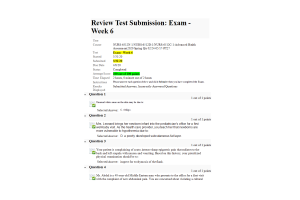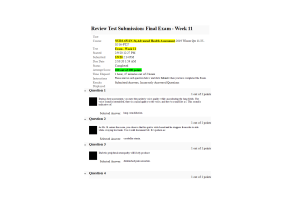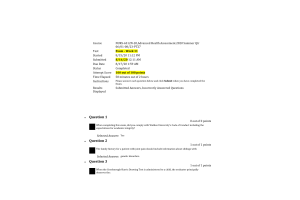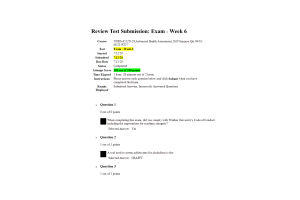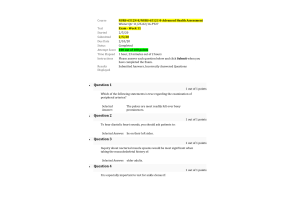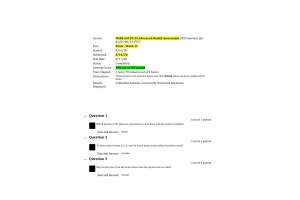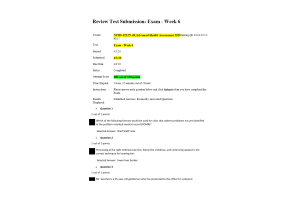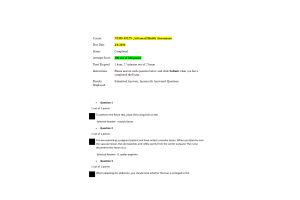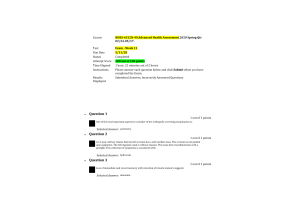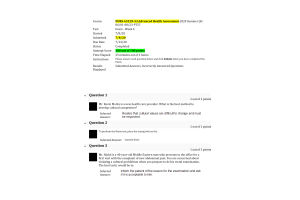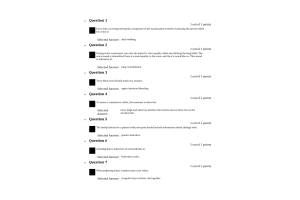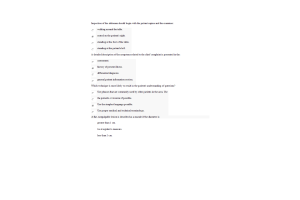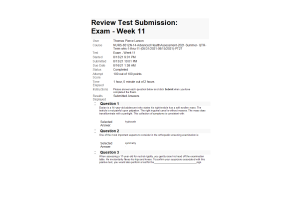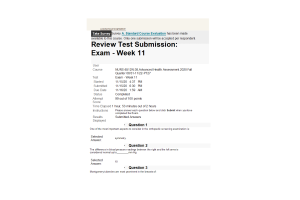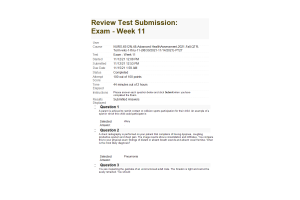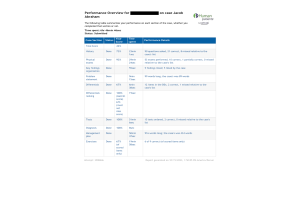NURS 6512N-19 Week 6 Midterm Exam (100% Correct)
- $65.00
- Question: A 5-year-old child presents with nasal congestion and a headache. To assess for sinus tenderness you should palpate over the:
- Question: When are open-ended questions generally most useful?
- Question: Mrs. Grace is a 58-year-old patient who has a diagnosis of pernicious anemia. Which B vitamin is deficient in patients with pernicious anemia?
- Question: You are planning to palpate the abdomen of your patient. Which part of the examiner's hand is best for palpating vibration?
- Question: Nuchal rigidity is most commonly associated with:
- Question: When you are questioning a patient regarding alcohol intake, she tells you that she is only a social drinker. Which initial response is appropriate?
- Question: Pigmented, raised, warty lesions over the face and trunk should be assessed by an experienced practitioner who can distinguish:
- Question: As part of your health promotion education for a new patient, you explain that the risk factors for skin cancer include:
- Question: To approximate vocal frequencies, which tuning fork should be used to assess hearing?
- Question: Tuning forks with a frequency of 500 to 1000 Hz are most commonly used to measure:
- Question: Mr. Abdul is a 40-year-old Middle Eastern man who presents to the office for a first visit with the complaint of new abdominal pain. You are concerned about violating a cultural prohibition when you prepare to do his rectal examination. The best tactic would be to:
- Question: The term denoting the caregiver's need to do no harm to the patient is:
- Question: Which of the following organs is part of the alimentary tract?
- Question: Mr. Walters, a 32-year-old patient, tells you that his ears are "stopped up." An objective assessment of this complaint is achieved by using the:
- Question: Mr. Kevin Marks is a new health care provider. What is the best method to develop cultural competence?
- Question: When assessing abdominal pain in a college-age woman, one must include:
- Question: A college student comes to the student health center complaining of difficulty in concentrating during class and while studying. The diet that would contribute to this problem is one that consumes mostly:
- Question: Tympanic thermometers measure body temperature when a probe is placed:
- Question: Inspection of the abdomen should begin with the patient supine and the examiner:
- Question: Mr. Jones is a 45-year-old patient who presents for a physical examination. On examination, you note costochondral beading, enlarged skull, and bowed legs and diagnose him with rickets. A deficiency of which fat-soluble micronutrient can result in rickets?
- Question: Mr. Williams, age 25, has recovered recently from an upper and lower respiratory infection. He describes a long-standing nasal dripping. He is seeking treatment
for a mild hearing loss that has not gone away. Information concerning his chronic postnasal drip should be documented within which section of his history?
- Question: Brittle nails are typical findings in:
- Question: Small, minute bruises are called:
- Question: The position on a clock, topographic notations, and anatomic landmarks:
- Question: Before performing an abdominal examination, the examiner should:
- Question: Mr. and Mrs. Johnson have presented to the office with their infant son with complaints of ear drainage. When examining an infant's middle ear, the nurse should use one hand to stabilize the otoscope against the head while using the other hand to:
- Question: In issues surrounding ethical decision making, beneficence refers to the:
- Question: The most common form of birth trauma of the scalp is:
- Question: A 17-year-old girl presents to the clinic for a sports physical. Physical examination findings reveal bradycardia, multiple erosions of tooth enamel, and scars on her knuckles. She appears healthy otherwise. You should ask her if she:
- Question: Expected hair distribution changes in older adults include:
- Question: Periods of silence during the interview can serve important purposes, such as:
- Question: A guideline for history taking is for caregivers to:
- Question: Mrs. Webb is a 38-year-old patient who has been changing her lifestyle to eat in a healthy way and lose weight. During your health promotion education regarding her nutritional status, you explain the function of dietary protein as:
- Question: Under normal circumstances, how much water is lost daily by the body?
- Question: A flat, nonpalpable lesion is described as a macule if the diameter is:
- Question: Expected normal percussion tones include:
- Question: A tool used to screen adolescents for alcoholism is the:
- Question: Unusual white areas on the skin may be due to:
- Question: Ms. Otten is a 45-year-old patient who presents with a complaint of weight gain. Which medication is frequently associated with weight gain?
- Question: When palpating the abdomen, you should note whether the liver is enlarged in the:
- Question: You are completing a general physical examination on Mr. Rock, a 39-year-old man with complaints of constipation. When examining a patient with tense abdominal musculature, a helpful technique is to have the patient:
- Question: When examining the skull of a 4-month-old baby, you should normally find:
- Question: Cherry angiomas are a common finding in:
- Question: Peritonitis produces bowel sounds that are:
- Question: You are collecting a history from an 11-year-old girl. Her mother is sitting next to her in the examination room. When collecting history from older children or adolescents, they should be:
- Question: Mrs. G. reports an increase in her alcohol intake over the past 5 years. To screen her for problem drinking, you would use the:
- Question: Your patient is complaining of acute, intense sharp epigastric pain that radiates to the back and left scapula with nausea and vomiting. Based on this history, your prioritized physical examination should be to:
- Question: Placing the base of a vibrating tuning fork on the midline vertex of the patient's head is a test for:
- Question: Recommended carbohydrate content of total dietary intake (% total calories) is %.
- Question: Which statement is true regarding the relationship of physical characteristics and culture?
- Question: A 22-year-old female nurse is interviewing an 86-year-old male patient. The patient avoids eye contact and answers questions only by saying, "Yeah," "No," or "I guess so." Which of the following is appropriate for the interviewer to say or ask?
- Question: Subjective and symptomatic data are:
- Question: Ms. Davis is a 27-year-old patient with a BMI of 33. Based on her BMI, your diagnosis would be:
- Question: Which is the best way to position a patient's neck for palpation of the thyroid?
- Question: In counseling a client regarding nutrition education, you explain that linoleic acid, a major fatty acid, is thought to be essential for:
- Question: A fixed image of any group that rejects its potential for originality or individuality is known as a(n):
- Question: Which of the following is an expected change in the assessment of the thyroid during pregnancy?
- Question: A blood pressure cuff bladder should be long enough to:
- Question: Which type of speculum should be used to examine a patient's tympanic membrane?
- Question: Mrs. Britton is a 34-year-old patient who presents to the office with complaints of skin rashes. You have noted a 4' 3-cm, rough, elevated area of psoriasis. This is an example of a:
- Question: Mrs. Kinder is a 39-year-old patient who presents to the office with complaints of an earache. In explaining to the patient about the function of her ears, which ear structure would you tell her is responsible for equalizing atmospheric pressure when swallowing, sneezing, or yawning?
- Question: When hearing is evaluated, which cranial nerve is being tested?
- Question: Your patient is complaining of acute, intense sharp epigastric pain that radiates to the back and left scapula with nausea and vomiting. Based on this history, your prioritized physical examination should be to:
- Question: Mr. Sanchez is a 45-year-old gentleman who has presented to the office for a physical examination to establish a new primary care health care provider. Which of the following describes a physical, not a cultural, differentiator?
- Question: When taking a history, you should:
- Question: You have just completed a skin assessment on Mr. Baker. During your assessment, you have transilluminated a skin lesion. During the physical examination, you know that skin lesions are transilluminated to distinguish:
- Question: The infant should be placed in which position to have his or her height or length measured?
- Question: Mr. Johnson presents with a freely movable cystic mass in the midline of the high neck region at the base of the tongue. This is most likely a:
- Question: Which part of the information contained in the patient's record may be used in court?
- Question: Mr. Black is a 44-year-old patient who presents to the clinic with complaints of neck pain that he thinks is from his job involving computer data entry. As the examiner, you are checking the range of motion in his neck and note the greatest degree of cervical mobility is at:
- Question: When assessing abdominal pain in a college-age woman, one must include:
- Question: The adult recommended dietary fat intake should be g/day.
- Question: Fluorescing lesions are best distinguished using a(n):
- Question: Which technique is most likely to result in the patient's understanding of questions?
- Question: Which of the following is the most accurate reflection of an individual's food intake?
- Question: Which question would be considered a leading question?
- Question: As you explain your patient's condition to her husband, you notice that he is leaning toward you and pointedly blinking his eyes. Knowing that he is from England, your Which question would be considered a leading question?
- Question: During percussion, a dull tone is expected to be heard over:
- Question: Tangential lighting is best used for inspecting skin:
- Question: Mr. L. presents to the clinic with severe groin pain and a history of kidney stones. Mr. L.'s son tells you that, for religious reasons, his father wishes to keep any stone that is passed into the urine filter that he has been using. What is your most appropriate response?
- Question: George Michaels, a 22-year-old patient, tells the nurse that he is here today to "check his allergies." He has been having "green nasal discharge" for the last 72 hours. How would the nurse document his reason for seeking care?
- Question: Which of the following occurs when firm pressure is used to apply the stethoscope's bell end-piece to the skin?
- Question: Spasmodic muscular contractions of the head, face, or neck are called:
- Question: After thorough inspection of the abdomen, the next assessment step is:
- Question: Mr. Mathews is a 47-year-old patient who presents for a routine physical examination. On examination, you have noted a bruit heard over the thyroid. This is suggestive of:
- Question: Mr. Mathews is a 47-year-old patient who presents for a routine physical examination. On examination, you have noted a bruit heard over the thyroid. This is suggestive of:
- Question: The review of systems is a component of the:
- Question: Mr. Franklin is speaking with you, the health care provider, about his respiratory problem. Mr. Franklin says, "I've had this cough for 3 days, and it's getting worse." You reply, "Tell me more about your cough." Mr. Franklin states, "I wish I could tell you more. That's why I'm here. You tell me what's wrong!" Which caregiver response would be most appropriate for enhancing communication?
- Question: Knowledge of the culture or cultures represented by the patient should be used to:
- Question: During an interview, tears appear in the patient's eyes and his voice becomes shaky. Initially, you should:
- Question: Mrs. Berger is a 39-year-old woman who presents with a complaint of epigastric abdominal pain. You have completed the inspection of the abdomen. What is your next step in the assessment process?
- Question: Which of the following formats would be used for visits that address problems not yet identified in the problem-oriented medical record (POMR)?
- Question: You are using an ophthalmoscope to examine a patient's inner eye. You rotate the lens selector clockwise, then counterclockwise to compensate for:
- Question: Underestimation of blood pressure will occur if the blood pressure cuff's width covers:
- Question: Your patient returns for a blood pressure check 2 weeks after a visit during which you performed a complete history and physical. This visit would be documented by creating a(n):
- Question: Which of the following is the most vital nutrient?
- Question: Mrs. Raymonds is a 24-year-old patient who has presented for a routine concern over her current weight. In your patient teaching with her, you explain the importance of macronutrients. Which of the following is a macronutrient?
- Question: The most superior part of the stomach is the:
- Question: Tracheal tug suggests the presence of a(n):
- Question: Your patient presents with symptoms that lead you to suspect acute appendicitis. Which assessment finding is least likely to be associated with this condition early in its course?
- Question: When completing this exam, did you comply with Walden University's Code of Conduct including the expectations for academic integrity?
